So, we finally got my mom to come visit us in Europe. But before making her way to Slovakia, she spent some time in the Netherlands and Belgium, and she thought it would be fun if we met with her in Amsterdam for several days before coming to little old Slovakia.
Terezia and I are apparently the only people in the world who've never been to Amsterdam. I've always wanted to go there but it's never been quite as high on my list of travel destinations. But now that we've been there, I'm not sure why it wasn't. We both found it to be a very cool and visually striking city that offered loads to do, and we were fascinated by the locals, who seemed to be incredibly hip, stylish and culturally switched-on, yet also laid back, friendly, and unpretentious.
Of course the first thing that's likely to hit you upon arriving in Amsterdam is a bicycle - at least if you're not paying attention. We saw plenty of near misses when tourists ambled into the bike paths without looking and were nearly pegged by one of the city's hundreds of thousands of cyclists. The locals really take advantage of Amsterdam's flatness and car
unfriendliness, and people of all ages ride their bikes everywhere. They get around on these big, janky, old cruisers, and you're just as likely to see them riding in sharp suits or dresses/high heels as jeans and sneakers. Some of the torrential downpours we endured on our trip didn't seem to thwart them at all, as some people would just ride holding an umbrella in one hand, or throw on a rain slicker.
The cyclists all seem to have mastered the art of not colliding into each other in intersections, they seem to co-exist just fine with the cars, and some cyclists have an Italian-on-a-Vespa-like predilection for not slowing down or altering their trajectory when clueless tourists stumble into their path. And the locals all looked incredibly fit and slender, no doubt helped in part by all the cycling.
Seemingly every inch of available space along bridge railings, near lamp posts, and any open spots on the sidewalks is taken up by parked bicycles. Sometimes a strong gust of wind would blow a row of parked bikes over like dominos, but no one seemed to mind much.
Of course what's probably most striking about Amsterdam is purely visual, with its gorgeous, tranquil, tree-lined canals and row after row of tall, elegantly narrow, gabled 400-500-year-old dwellings that lean and sag precariously from side to side.
Since Amsterdam was built on reclaimed land in the marshy delta of the Amstel River, the inhabitants built their structures on foundations of long, wooden beams driven vertically deep into layers of mud and sand. Over the centuries the buildings would naturally settle a bit, resulting in these amusingly crooked facades with windows and doorways shaped like parallelograms.
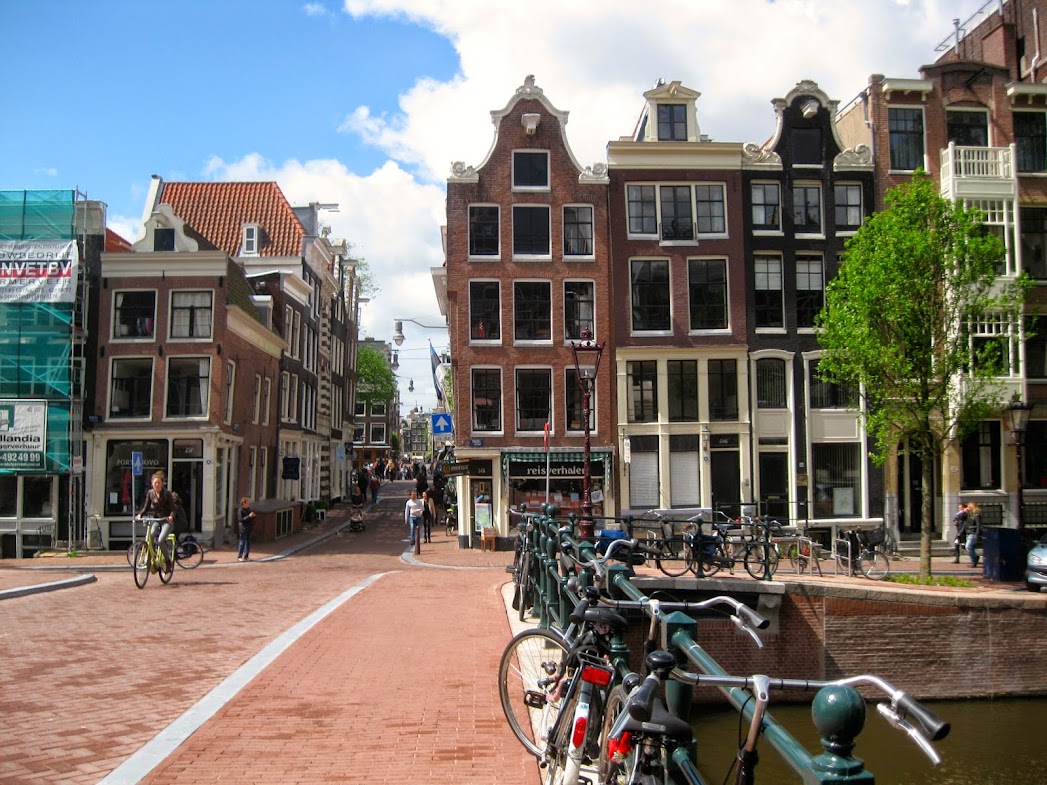
Many of these old facades actually lean forward at slightly disconcerting angles, but we learned that this was actually intentional. You see this on the many buildings that have a short beam that extends outward horizontally from the tip of the gable with a hook at the end. Back in Amsterdam's Golden Age in the 1600s, merchants would store the goods they would sell in the top, attic level of their buildings, and used these beams with pulleys and hooks to hoist the goods up outside and load them in through the window. People would use this system to move furniture onto the upper floors of their homes, too. The buildings' facades were designed to lean forward so that stuff wouldn't bang into them when being hoisted up.

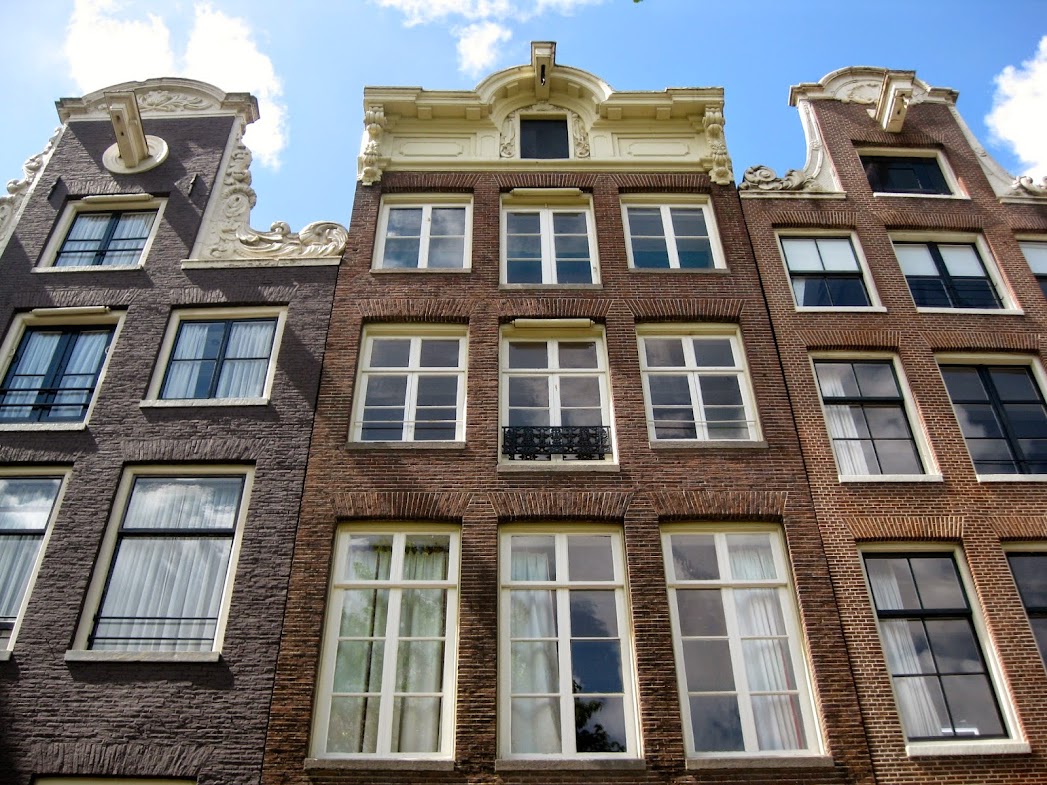
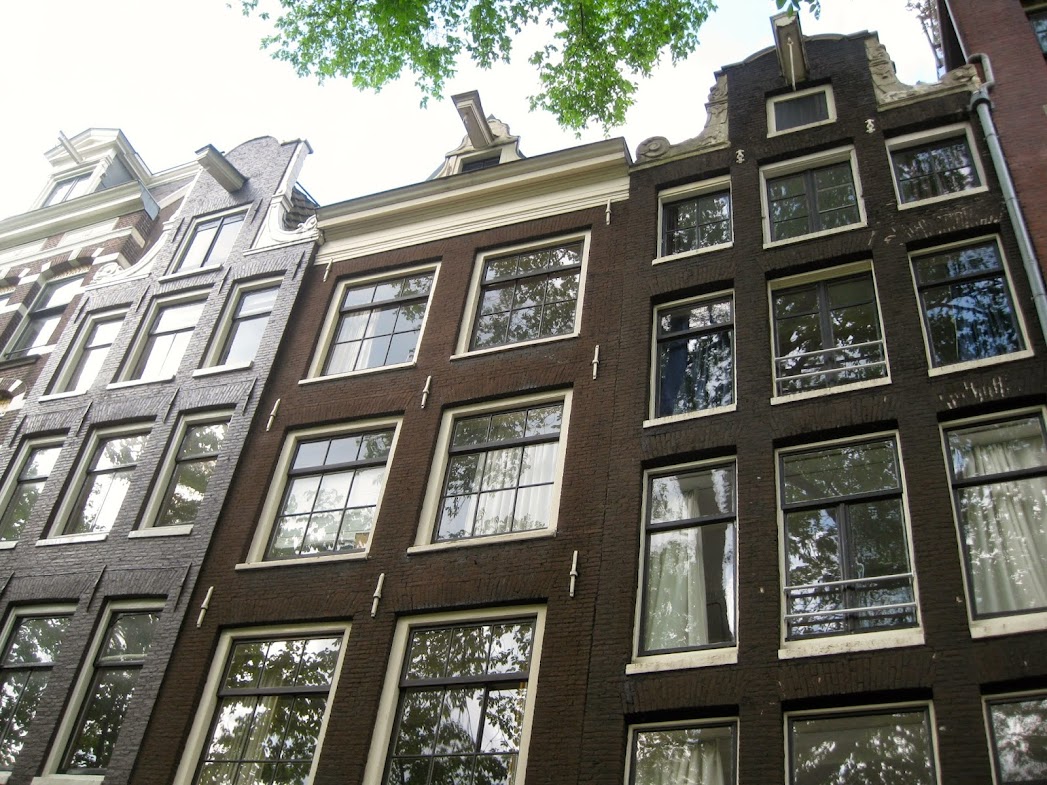
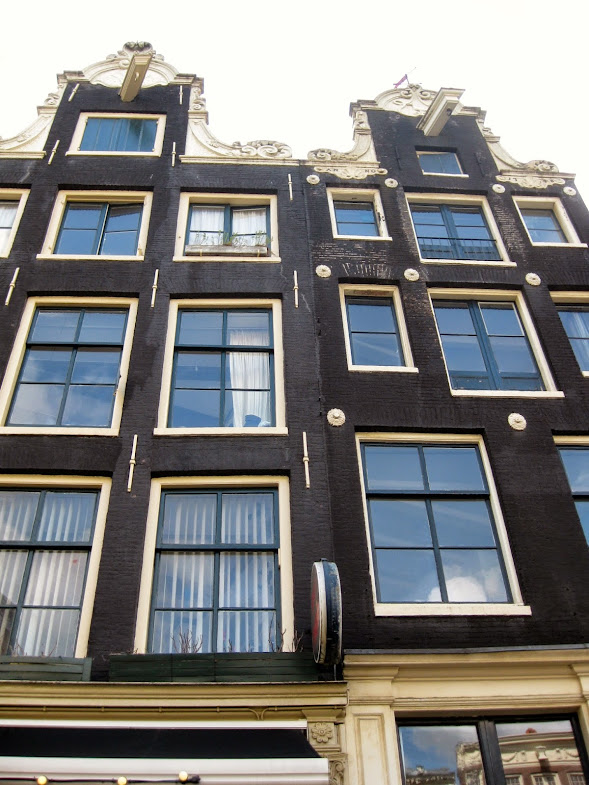
These buildings were often very narrow because the city would tax people based on the width of their homes. Though there were a handful of rich merchants who flaunted their wealth by building wide palaces, the vast majority of people opted for lower taxes and went narrow with their homes, many of which, however, extend back lengthwise quite a bit.
At any rate, these seemingly endless rows of buildings may at first glance seem a bit samey, tidy and symmetrical, especially since they all seem to have similarly paned windows and sparely designed facades that vary little from one dwelling to the next. But the dark colors, the austere quality of the facades (at least below the ornate gables), the precariously slanting angles and the shimmering, tree-lined canals all really make for an appealing, almost brooding kind of atmosphere.
This is especially apparent in the Western canals, which lie just west of the city's central, medieval core, and the Jordaan district, which lies just west of the Western canals. I was told these two boroughs are inhabited by a mix of yuppies and artists. It seemed like nearly every time I glanced through a front window I saw either a spacious, airy, loft-like office space with big, sleek, modern drafting tables, Mac computers, and Eames-ish/Herman Miller-ish furniture,
or a stylish living room with Eames-ish/Herman Miller-ish furniture, large book cases filled with massive art books, and tasteful modern art on the walls.
Several streets in these areas are also bustling with local life, with a slew of welcoming, pleasantly offbeat, low key and atmospheric cafes and restaurants, uber-fashionable clothing boutiques (and some promising looking vintage clothing shops, too), artisanal cheese shops and bakeries, vintage junk shops, and bookstores galore. I also saw a slew of furniture shops selling stylish, vintage-modern Eames-ish knock-offs.
 |
| Bookstore near Spui Square with cool Art Nouveau front. |
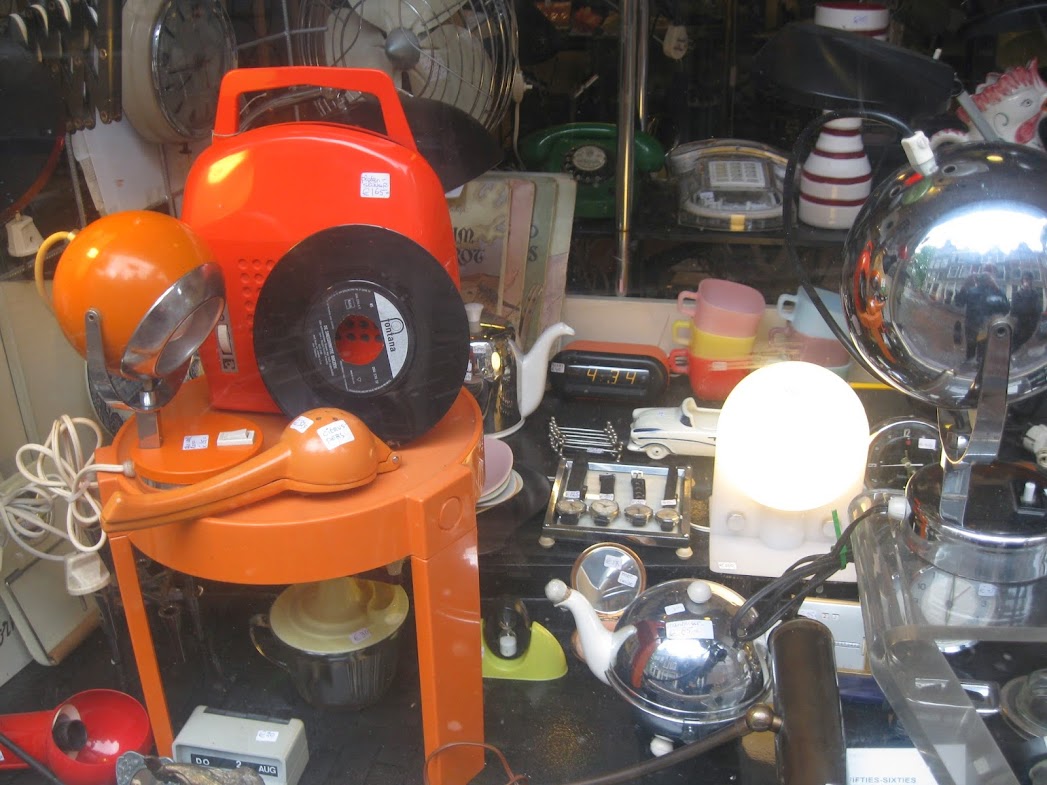 |
| Some cool clutter in the window of a junk shop in the western canals area. |
It was clear that the locals actually enjoy hanging out in these cafes and being social. In fact, the cafes, in particular, possess a really striking ambience. You can get some (always very good) coffee, but they're also great places for lunch, where you can feast on these ginormous, open-faced sandwiches. But all these cafes evoked a pleasingly offbeat atmosphere with old, vintage furniture, and much older lightly-painted wood-paneled walls, with huge windows that let in diffused light, charmingly funky decor and stylish but always friendly and welcoming staff. These places seemed a bit Parisian, but also a bit like Berkeley or San Francisco, but without the attitude. Either way, it's a kind of vibe and aesthetic that seems a bit elusive in Bratislava.
In Slovakia many cafes are either of the old-school, formal Viennese variety, where you're served by guys in crisp white shirts and bow ties, or they are often these super sleek, modern joints with about as much soul as a Starbucks. But there was something about Amsterdam's cafes that made us feel at home. I'd rather have my cappuccino served by a casually-dressed, tattooed and bespectacled barista than by some stiff dude with a mustache and a tux.
The Red Light District
My mom wasn't particularly interested in seeing the Red Light District, but Terezia and I were genuinely curious to see what legal, regulated prostitution looks like. It's strictly forbidden to photograph any of the prostitutes in the windows, and apparently, if you try to photograph them a burly bouncer will come charging out of the building and take your camera or phone away. (I wonder if they've had any run-ins with nimrods wearing Google Glass?) So, I don't have any photos of the area, but it'd be weird to take photographs of these working ladies anyhow, especially since even though the area is an undeniable tourist attraction, they're actually there to work and make a living. (But you can do a Google image search if you're really curious.)
 |
| Belle, the Red Light District's statue honoring sex workers around the world. |
The area of the map that marks the Red Light District is slightly misleading - it's not totally lined with wall-to-wall prostitutes leering at you through windows. Most of the area consists of a mix of sex and fetish/S&M shops, porno theaters, strip clubs, "coffee shops" (where pot is sold and smoked), and ethnic restaurants, while really only certain stretches offer window after window of prostitutes. The windows are full-length, and on the narrower side streets they are right at street level, allowing you to pass by just inches away from the scantily-clad women. Most were wearing very skimpy underwear and bras, although one was - quite amusingly - just sitting cross-legged on a stool, fully dressed in a tweed skirt and long-sleeved black turtleneck with smart glasses, intently reading an iPhone. Was she targeting guys with a naughty librarian/tech-geek fetish?
The women all seemed to be in their 20s and 30s; most were slender, some slightly more voluptuous, with a few even covered in tattoos, and they all seemed to look healthy and attractive, although many of 'em were wearing way too much make-up, and we even noticed two with missing front teeth. A few looked stoned out of their gourds, while most just smiled and tried to playfully catch eye-contact with passersby. Some were half-heartedly dancing to music that only they could hear in their booths.
Apparently, if the women's booths are illuminated with red lights, they are women, but if you see a blue light - it's a transvestite. This is actually due to a regulation put in place to prevent the more convincing-looking transvestites from giving an unsuspecting straight client an unpleasant surprise.
We were there in the evening before the sun had set, so the streets were filled with a mix of curious tourist couples, random young ruffians, obnoxious groups of drunk and/or stoned frat boy/stag party types, sad R. Crumb-ish middle-aged guys who actually seemed to be shopping around, and even a few roving bachelorette parties.
 |
| The Old Church in the Red Light District. |
Traditionally, Amsterdam's prostitutes have been independent, self-employed workers, and the system removed the pimps and crime from the equation. But apparently a huge number of brothels in Amsterdam have been shut down in the last several years due to organized crime groups from Eastern Europe and Russia having infiltrated the market, whose super sketchy practices were in conflict with the city's way of doing things.
Cannabis
Of course everyone knows about Amsterdam's laid back attitude towards pot, and that people are allowed to purchase and smoke it in what are euphemistically called "coffee shops". We didn't go into any, but what we found interesting was how the coffee shops in the less touristy neighborhoods, such as a couple of them near our hotel that we passed by several times, had an ambience similar to cafes, and the clientele appeared to consist more of locals and people in their 40s or 50s. By contrast, the coffee shops in the touristy areas and the Red Light District had super tacky signage with bad euro-disco blasting out the front door and seemed to cater mainly to imbecilic stag party types and young tourists. These places also seemed to be piping out pungent pot fumes into the street to lure people in.
I have to say, I'm really surprised it's taking the rest of the world so long to follow Amsterdam's lead with this. To us it seems silly that a drug that's less harmful than alcohol isn't decriminalized everywhere. If you allow it and regulate it, you eliminate the crime and you reduce the number of people you're putting in prison. Of course a few states in the US have recently adopted more tolerant laws, but there's a long way to go.
As Rick Steves says, it's not that the Dutch are all pot-smoking, prostitute-procuring hippies; they're just interested in finding practical and smarter ways to deal with certain issues. But I do suspect the general laid back approach to life that we encountered there probably plays some role in their willingness to consider and adopt more tolerant policies.
Dam Square and kind of boring cathedrals
Some European cities can boast of dizzyingly beautiful, extremely well-conceived and inviting public squares (Prague, Siena, to name a few), while others are curiously devoid of 'em. Unfortunately, Amsterdam falls into the latter category. Actually, its smaller, more intimate squares are fine, but the medieval center's main public place, Dam Square, is a massive, cold, uninviting place with an unappealing, not particularly cohesive blend of architectural styles. The only potentially rewarding view is in the direction of the New Church (built in the 15th century), though even that isn't all that spectacular. The square is kind of centered on this big, white, phallic WWII monument, which seems to be the only place on the sprawling square where one can perch. Dam Square and the web of busy, bright tourist-shop-cluttered streets that intersect it were not places we wanted to spend more time than we had to.
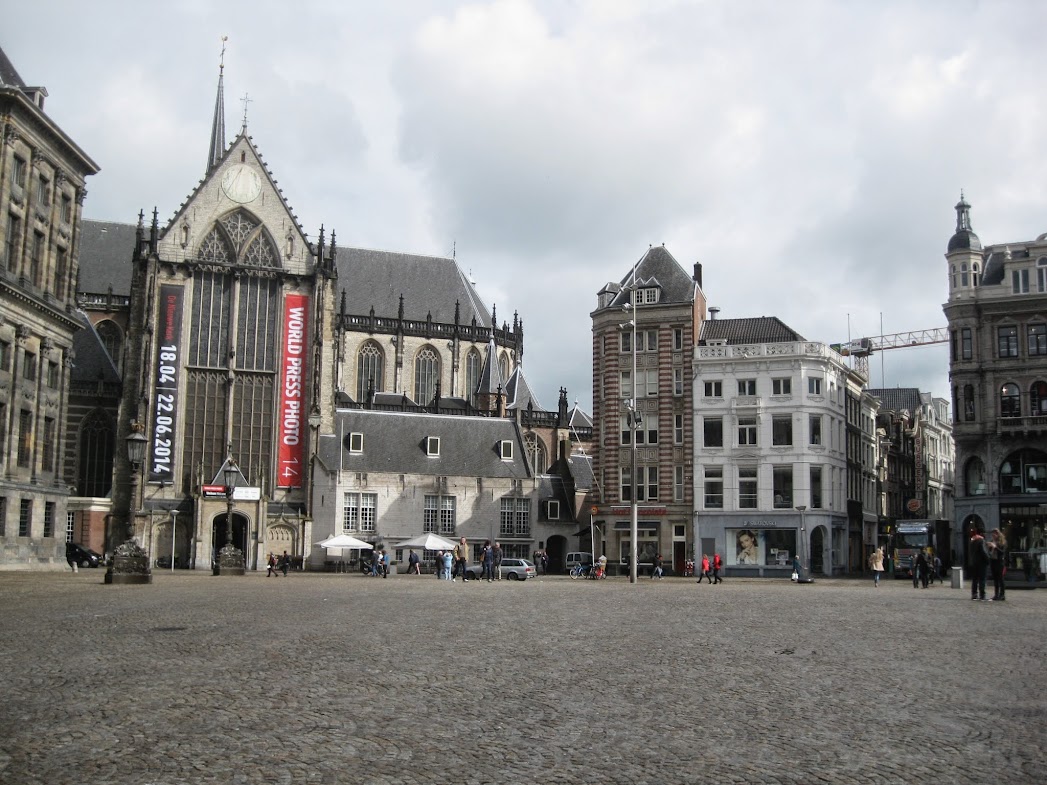 |
| Dam Square, facing the New Church. |

Amsterdam is also not a place to check out Gothic cathedrals. I mean, they have 'em, with the biggest, most central ones being the New Church and the Old Church, but due to the overwhelming popularity of Protestantism in Amsterdam in the city's so-called Golden Age, and the suppression of Catholicism, the cathedrals have none of the intricately ornate and flowery designs. The interiors are massive and cavernous, but totally devoid of any of those Gothic or Baroque altars or chapels that line the sides of the Catholic haunts, as well as any silly Baroque ceiling paintings or Renaissance wall frescoes. You've got an intricately wood carved pulpit, a lovely and massive organ, and that's it; otherwise it's four walls and a cross, Protestant-style. This is because when fighting the Catholics, the more extreme Protestants (the Iconoclasts) would go into the Catholic churches and literally smash everything inside, even the stained glass windows, as they saw it as excessive and decadent. Even though I'm strictly non-religious, I prefer seeing the crazy and ornate designs and artistry of the Catholic structures.
Lots of rain = lots of time spent in museums
The weather was being kind of an asshole on our four-day visit. At some points we had to contend with some nasty downpours, umbrella-busting gusts of wind, and temperatures that were almost wintery (it certainly got down into the 40s Fahrenheit). Not the warm spring weather we'd have liked, but what can you do? So, we spent a lot more time in museums than we otherwise would have. But that's okay, since Amsterdam's bursting with stuff to do indoors, including at least three sprawling, world-class art museums.
On Friday we opted for the Van Gogh museum, which houses a pretty big collection of works that were owned by Vincent's brother Theo, and its focus is more on Van Gogh's development and progression from somber, impressionistic paintings to the full-blown intense, thickly painted images that made him a household name after his death. There is quite a lot of his earlier, pre-Arles/pre-crazy landscapes and intense self-portraits, although there definitely is some of that. The museum was
unpleasantly crowded - you kind of had to wait in line to see the more popular paintings. But it's always nice to take a gander at Van Gogh's work in person, whether it's the gloomy, almost Norman Rockwell-on-reds peasant caricatures in the potato eaters, or the colorful later self-portraits.

For Saturday we chose the Stedelijk, Amsterdam's 20th-century modern art museum. Housed in a beautiful, old, brick palace that has been fused to this hulking bathtub-like monolith, the museum contains a fascinating collection of Dutch cubist and abstract painters, some of which I'd never heard of, in addition to cats like Mondrian, and of course, some of the usual suspects, like Picasso, Braque, Calder, Chagall, Kandinsky, Pollack, etc. As impressive as it was, I'm almost slightly surprised to report that Prague's modern art museum actually has a more robust Picasso and Braque collection (but maybe that actually makes sense, since the Czech cubists were a major part of Prague's early-to-mid 20th century art scene, and as such, there was probably extra interest from the Czechs in securing paintings from those artists).
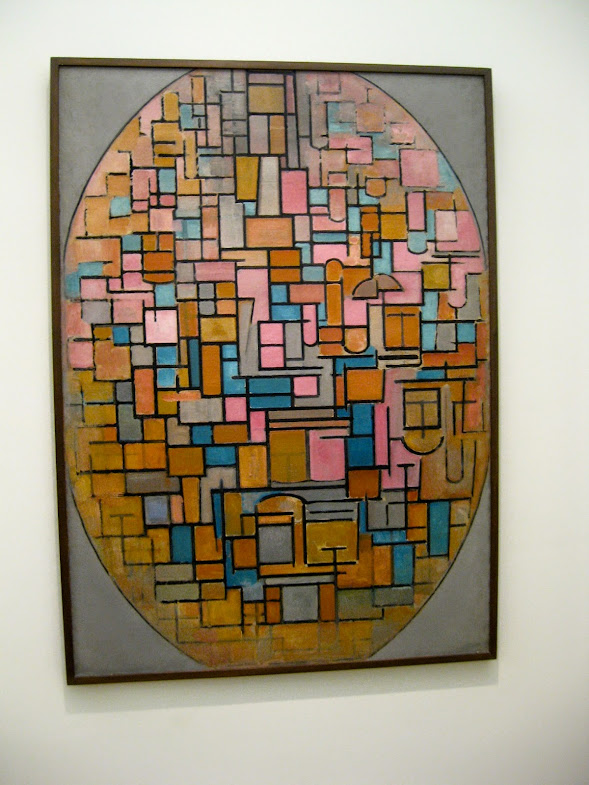 |
| Mondrian before he went all grid based. |
 |
| Neo-classical meets neon at the Stedelijk. |
The Stedelijk also had several rooms dedicated to design, with some amazing 20th-century modern furniture and groovy, futuristic stereo components and other household items.
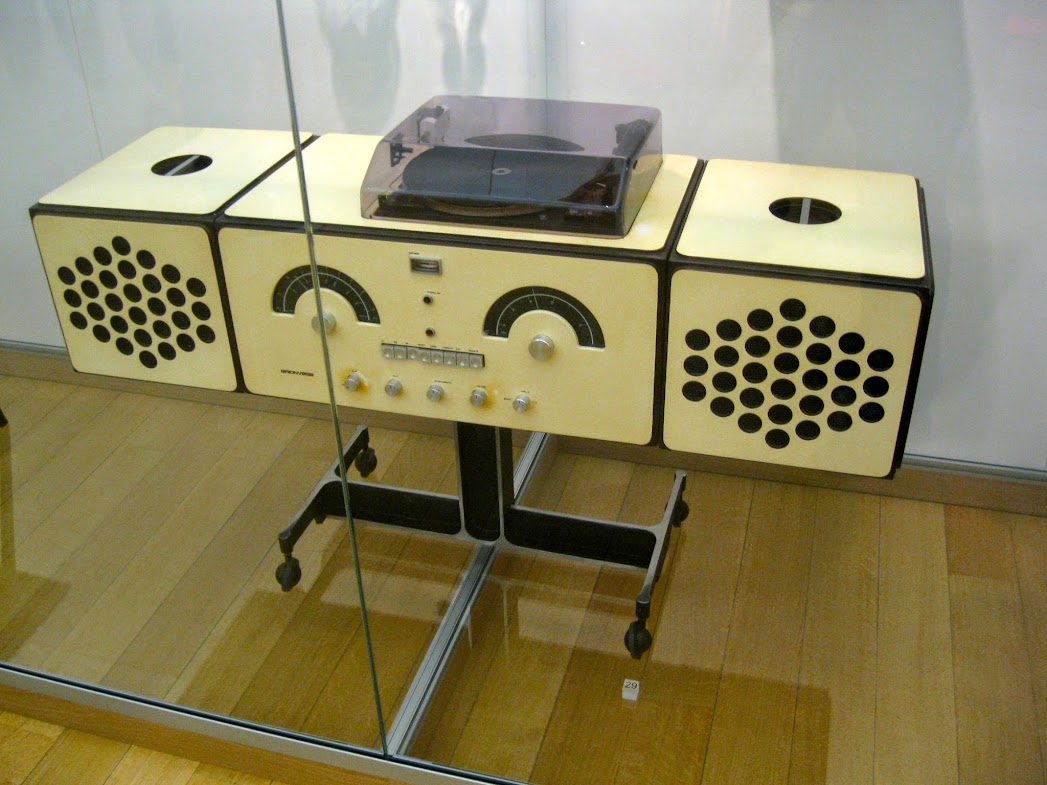 |
| This stereo looks amazing but probably sounds horrendous. |
And I was wildly excited by these two massive walls in this big corridor that were lined floor to ceiling with reproductions of posters for exhibitions of 20th-centrury modern artists (and a few 19th-century ones too). I wanted every damn one of 'em. If I lived in Amsterdam I'd line the walls of our apartment with these things.
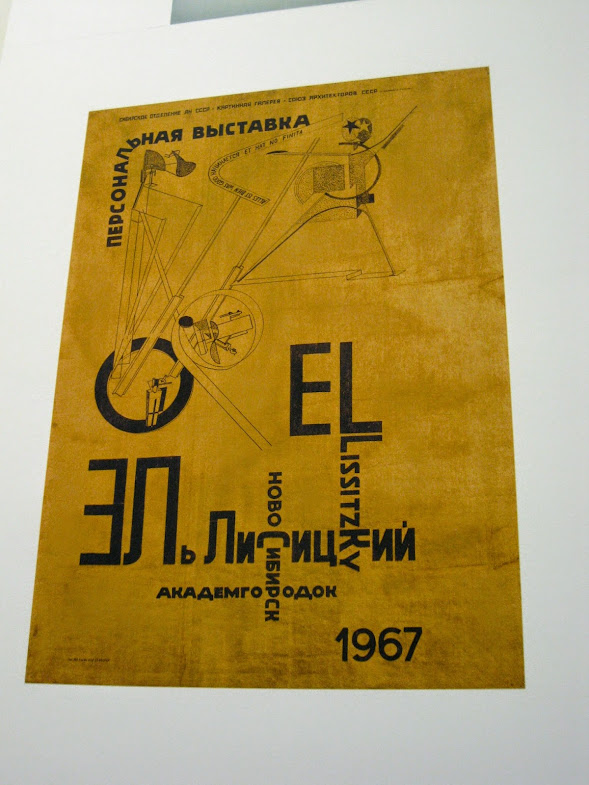 |
| This poster incorporates one of my favorite El Lissitzky pieces. I am nuts about Russian Constructivism. |
We saved the stupefyingly massive Rijksmuseum for Sunday morning, which worked out well since it rained that day nonstop from dawn until three in the afternoon. Its enormous collection focuses on Rembrandt, Vermeer, and countless other Dutch Golden Age masters who were obsessed with lightness and dark, photographic detail, and the everyday lives of milkmaids and peasants and vases of flowers (although there are plenty of politicians, wealthy burghers, and Waterloo). To be honest, while I do appreciate this stuff, it's less exciting to me than, say, cubism, futurism, or even impressionism, but it really is cool to see some of these works in person. I definitely like the atmosphere these Dutch guys evoked in their paintings, complete with diffused light and loads of melancholy darkness.
The Rijksmuseum also had a few choice Van Goghs.
The food
If you're not interested in pickled herring, cheese soup, or potatoes, then Indonesian food is the way to go food-wise in Amsterdam. On some streets it seems there's an Indonesian joint on every block, and the two Indonesian establishments we tried were jam-packed with both locals
and tourists.
Our experience with Indonesian food is admittedly limited, and it was recommended that we order the rijsttafel (which means 'rice table') for which they bombard you with a slew of small plates containing a variety of items. The restaurants serve one rijsttafel order for two people, costing 25-30 euros per person, but we found this was more than enough for three people, which works out okay because you still pay the two-person price. We tried two of the city's top 4-5 most highly rated Indonesian restaurants on Yelp - Sampurna, near the flower market along the Singel canal, and Kantjil & de Tiger, by Spui Square.
 |
| The rijsttafel at Kantjil & de Tiger. |
Both places had good points and not-so-good points: they both offered an interesting array of meat, chicken, and seafood in super rich, flavorful and sometimes spicy sauces. But Sampurna seemed to have a better handle on its meat - most of the chicken and beef was mouthwateringly tender and juicy - whereas Kantjil had a slightly better variety of sauces, yet its chicken and beef were a bit tougher and drier (their fish was fine, though). I'm sure there's a restaurant in this town that nails
everything - we just didn't have time to find it.
On our third night we tried what was the city's most highly rated Thai joint on Yelp: Bird. Sadly, I think they should consider changing their name to Turd, because the food here was pretty unimpressive. My mom ordered a panang curry that was actually reasonably good, but my green curry chicken was very middle-of-the-road, while Terezia's Pad Thai was inexcusably awful. There was clearly a lack of love in the kitchen, as this stuff was being churned out by robot-like workers. Even stranger was how the place was absolutely packed, and on our way out we walked past a line of people 10 or so strong waiting for a table. I'm certain good Thai food exists in Amsterdam, it would just take a little more research to find it.
I mentioned those pleasantly atmospheric cafes up above, and those that we tried all seemed to make really good lunch food. The best place was called Singel, and one sandwich there consisted of thin, super tasty, warm slices of smoked chicken under a pile of creamy melted brie, with avocado and sundried tomatoes, and fresh herbs sprinkled on top, served open face over a big, toasted baguette. This was the most memorable sandwich I've had in a while. What was especially amusing about these Dutch sandwiches is that they give you a fork and a steak knife, and that's how the locals eat them, which makes sense given that sometimes these suckers were far too big to manage with one's hands.
At one point some nasty rain forced us to seek shelter in a bakery/cafe where Terezia and I shared this sublimely dense and moist slice of carrot cake with cream cheese frosting. This place seemed to offer a lot of things you might expect at an artisanal bakery in San Francisco or Oakland, yet had that cool vibe of an Amsterdam cafe. We noticed a few places like this when wandering around the city.
The locals
The city's inhabitants all seemed to be slim and healthy, smartly and fashionably dressed, but also incredibly friendly, very laid back and noticeably unpretentious and non-snooty - all regardless of age. No one seemed to be in a particular hurry, and locals would linger lazily in cafes and restaurants, and pretty much every single person who served or waited on us or rang us up at a register was friendly and approachable.
It's quite common for Dutch people to learn English, and many learn it from an early age and become fluent. Literally everyone we spoke to, after first addressing us in Dutch, would then switch on a dime into fluent English and seemed perfectly cool about it.
And this laid back vibe extended to the streets: even when narrowly missing each other or pedestrians while cycling through the lanes, they'd usually maintain a sense of zen-like calm.
It's interesting to see the differences in style and in the way people carry themselves, between Amsterdam and, say, Bratislava. Right off the bat Terezia noted that the Dutch men all seemed to be incredibly good looking and smartly dressed. I noticed that the women were more fashionably hip in a way that's similar to the women you see in Paris - that is, more casual yet at the same time more hip, or more urban, if that makes sense.
Amsterdam is also very ethnically diverse and cosmopolitan, which is always nice.
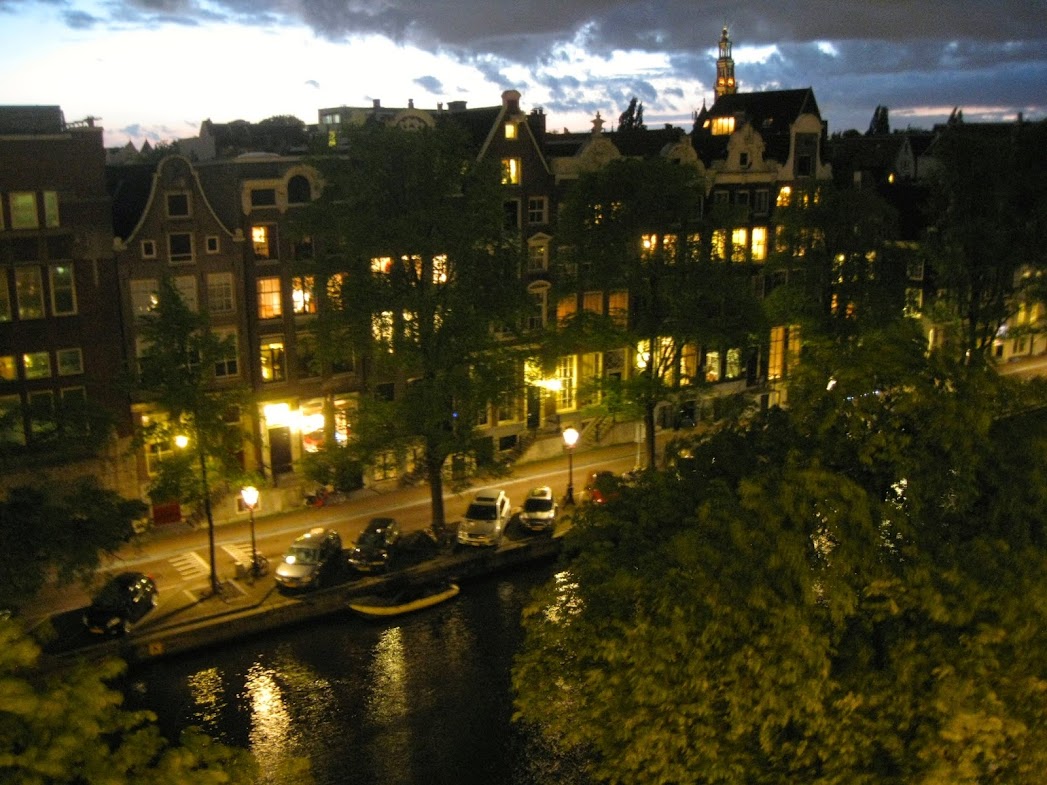 |
| Night view from the hotel room. |
Despite such vast areas of the city being given over to preserving the past, Amsterdam struck us as a pretty forward-thinking place, and its inhabitants as very culturally switched-on. There's a real design-y, stylish feel about the place. In the less touristy areas the locals seem to be really into a simple, elegant, modern aesthetic, which is reflected in the tasteful signage of their cafes or shops, or the creative ways in which people deck out their shop interiors. It seems like a lot of value is placed on the arts, and the people appreciate the city's rich artistic history, while staying very much dialed-in to this kind of modern aesthetic. Does that make even sense? Go there, if you haven't already, and you'll see what I'm getting at with this.
Finally, the locals also seem to be invested in their city, and enjoy living in it. They seem to be engaged in actively making it an interesting and livable place. They take care of it, and keep it very clean. (Maybe almost too clean - you certainly don't see much dilapidation there.) This is all kind of a striking contrast from Bratislava.
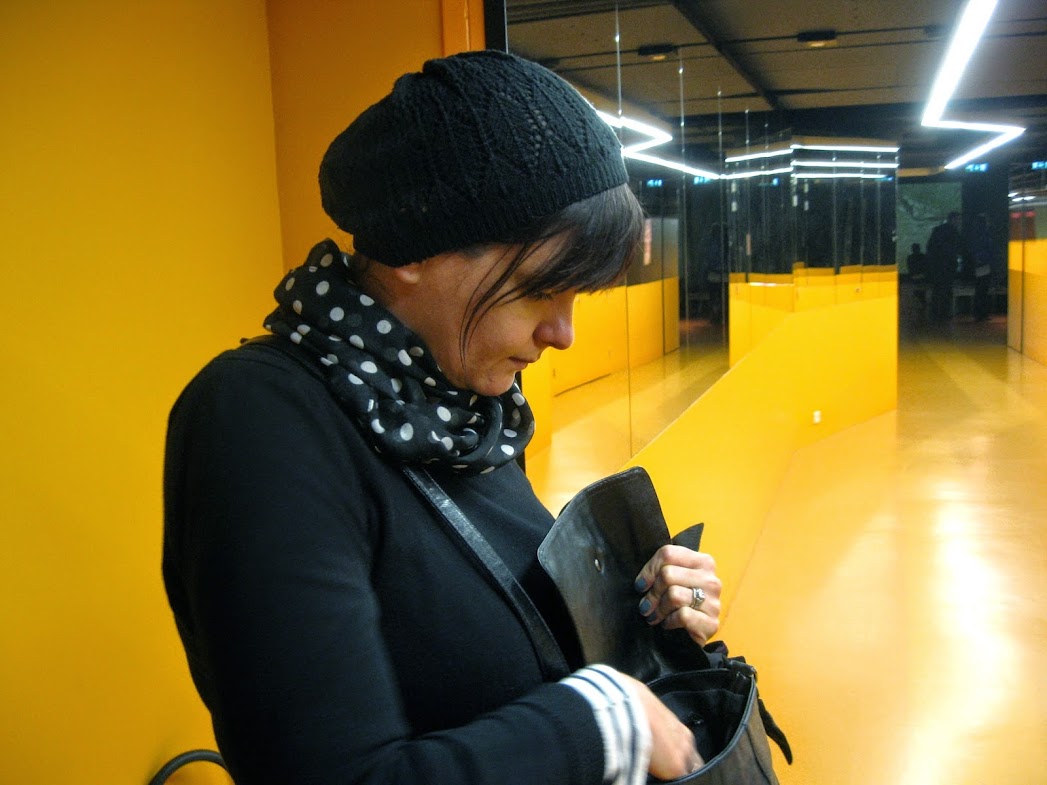
Terezia also had an interesting observation: it seems that if you can get the money together to start up your own bakery, cafe or shop and you've got something that's genuinely good, interesting, or different to sell, the locals will be into it. When we first moved to Slovakia and were figuring out what to do work-wise, Terezia had several ideas, like opening a small, high-end sandwich shop or bakery selling non-Slovak things, or even trying to open the city's first food truck, offering something slightly different or more exotic for people at lunch, etc., but every local Bratislavan she'd speak to about it would immediately poo poo the idea for one reason or another. But in Amsterdam one gets the sense that people are less rigid and more open to new or different things. Maybe this open-mindedness is engrained in the culture after they spent centuries exploring the world in search of new and exotic goods to sell and import.
Public transportation was a breeze. Smooth, clean, modern trams traverse the city's major arteries, and while the locals get to where the trams don't via bicycle, the lack of hills makes it super easy to get around on foot. It's a very walkable city. Getting from Schipol airport to the central train station couldn't have been easier - a train ride costing 4.50 euros takes you right from the airport to the center of town in under 20 minutes with no stops in-between. My only gripe was that single tram tickets for an hour-long ride are exorbitant at 2.80 euros per ticket (to give you some perspective, in Bratislava, a single 15-minute ride costs 70 cents, while 90 cents gets you an hour and 10 minutes with transfers). The locals all use these cards that they refill each month, but you can buy 24-hour or 48-hour tram tickets, which will pay for themselves if you use the tram or bus several times.
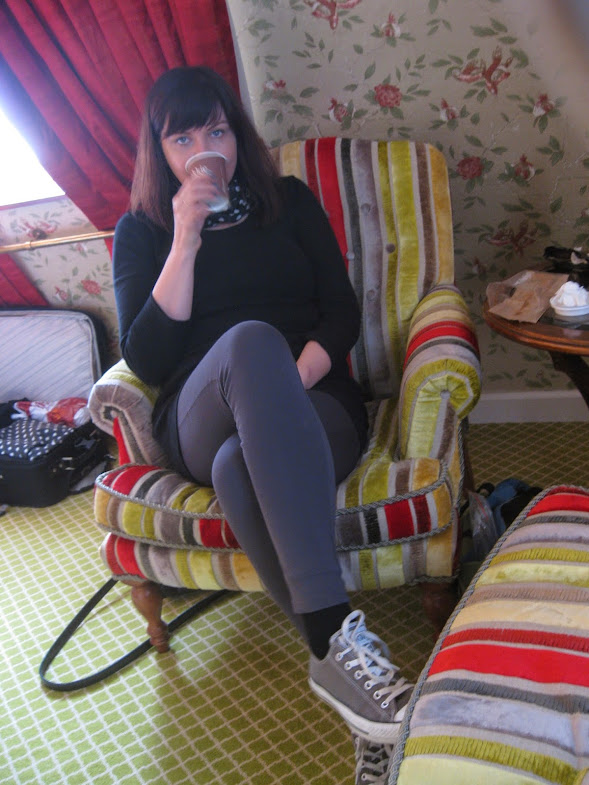 |
| Terezia in the hotel room sipping the free coffee. |
We had just enough time to get a pretty good feel for the place, but felt like we could easily spend a full week there, and we'd certainly go back. Hopefully that'll happen sooner rather than later.
